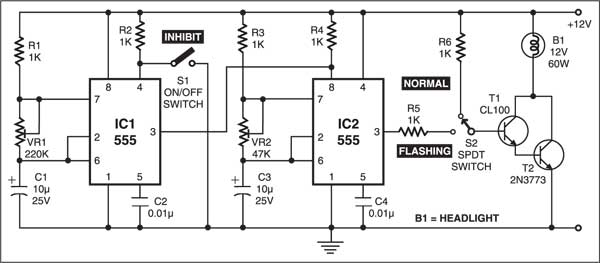 The dipper for a vehicle’s headlight changes the light from high beam to low beam or vice versa given a particular set of road conditions. The shifting of light from high to low beam reduces the dazzle for those approaching head-on towards the vehicle. But the dip beam (or low beam) sometimes fails to attract attention of the riders coming from opposite direction. The same is particularly true for blind, steep turns of the roads. A solution for this problem is a flashing headlight that will attract attention immediately.
The dipper for a vehicle’s headlight changes the light from high beam to low beam or vice versa given a particular set of road conditions. The shifting of light from high to low beam reduces the dazzle for those approaching head-on towards the vehicle. But the dip beam (or low beam) sometimes fails to attract attention of the riders coming from opposite direction. The same is particularly true for blind, steep turns of the roads. A solution for this problem is a flashing headlight that will attract attention immediately.
Flashing headlight for vehicles
Here is a simple flashing headlight circuit for motorbikes. It is built around two 555 timer ICs.
The first astable multivibrator wired around IC1 introduces a pause interval between the flashes generated by the second multivibrator wired around IC2. The flashes pause for the ‘off’ duration of IC1, which makes pin 8 grounded to prevent the flashes if switch S2 is towards flashing mode. Pause duration can be adjusted using preset VR1.

The second astable multivibrator works only during the ‘on’ time of the first astable multivibrator. The flash rate can be varied with the help of preset VR2.
The circuit produces 3 to 6 flashes per second at an interval of 2 seconds. It makes the headlights to flash and then pause, again flash and then pause, and so on.
As headlight bulbs draw a large current, a Darlington pair of transistors T1 and T2 is used to conduct the required current without damaging the transistors. Use heat-sinks with transistors.
Switch S1 is used to inhibit the flashes. With switch S2 you can choose between normal and flashing modes of headlights.
The circuit operates off the motorbike’s 12V battery.
The article was first published in November 2003 and has recently been updated.






